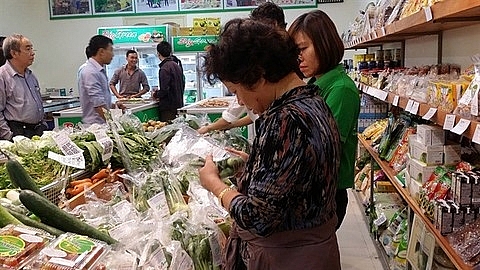Hanoi promotes supply chains
 |
| A safe food shop on Ta Quang Buu Street in Hanoi. The capital city has developed 80 food safety supply chains, of which 36 are of animal origin and 44 are of plant origin. - VNA/VNS Photo Do Phuong Anh |
The capital city has developed 80 safe food supply chains, of which 36 are of animal origin and 44 are of plant origin, according to the Hanoi Department of Agriculture and Rural Development.
Hanoi is also implementing a pilot programme granting safe-food certificates for 11 production units in the vegetable and meat supply chains, and for 23 food shops.
Hanoi has over 10 million residents with rising demand for agricultural products. However, the city’s production output meets only 60 per cent of its needs, while many products are dependent on neighbouring localities.
According to estimates, Hanoi’s rice output provides just 35 per cent of the city’s demand. This number for beef production is 15 per cent, seafood 5 per cent, and processed food 20 per cent.
The area for growing vegetables in the city is currently estimated at over 10,000 hectares, satisfying 66 per cent of consumption demand. For the rest, the city must rely on supply from neighbouring provinces such as Hung Yen, Ha Nam, Bac Ninh and Vinh Phuc.
Twenty-one localities provide safe food for Hanoi, creating a production and supply chain of agro-forestry-fishery products for the city.
In the first six months of this year, Dien Bien Province provided about 50 tonnes of agro-forestry-fishery products for Ha Noi, while Vinh Phuc supplied 2,500 tonnes of vegetables, three million eggs, 60 tonnes of chicken meat, 500 tonnes of pork and 100 tonnes of fish.
According to the Hanoi Department of Agriculture and Rural Development, supply chains between Ha Noi and other provinces remain limited. One of the reasons is that some localities have yet to develop annual co-operation plans for each sector.
On the other hand, many provinces do not have specialised agencies or departments in agricultural trade promotion to maintain regular co-operation between enterprises.
At the same time, current policies to attract Hanoi’s enterprises to invest in processing agricultural products have not been fully developed. Some products sold at chain stores do not have brand names or identification information. The amount of farm produce supplied to Ha Noi through co-ordination remains modest.
Therefore in order to diversify the agricultural products supplied to the capital city, the authority needs to step up coordination with provinces in food quality management and food safety, checking sample quality of their products for traceability.
In particular, Hanoi should build a mechanism to create favourable conditions for businesses to invest in processing, linking and selling products to farmers, building high-tech agricultural models.
What the stars mean:
★ Poor ★ ★ Promising ★★★ Good ★★★★ Very good ★★★★★ Exceptional
 Tag:
Tag:
Related Contents
Latest News
More News
- New initiative to boost the fight against domestic violence (November 26, 2025 | 10:00)
- South Korea funds IOM relief for Vietnam’s typhoon-affected communities (November 24, 2025 | 15:33)
- AI and human-centred values set to shape the future of HR in Vietnam (November 21, 2025 | 18:04)
- Kimberly-Clark and UNICEF strengthen child and maternal healthcare (November 17, 2025 | 18:08)
- Nestlé expands support for education and active lifestyles in Vietnam (November 17, 2025 | 17:52)
- Swing for the Kids Foundation supports school upgrades in Nghe An’s Do Luong district (November 16, 2025 | 10:00)
- Australia provides further $520,000 in typhoon aid to Vietnam (November 14, 2025 | 17:47)
- EU boosts emergency aid after Typhoon Kalmaegi (November 14, 2025 | 17:42)
- Pfizer Vietnam hosts symposia on pediatric pneumococcal disease (November 14, 2025 | 09:00)
- University of Medicine and Pharmacy develops vaccinology postgrad course (November 11, 2025 | 17:15)























 Mobile Version
Mobile Version